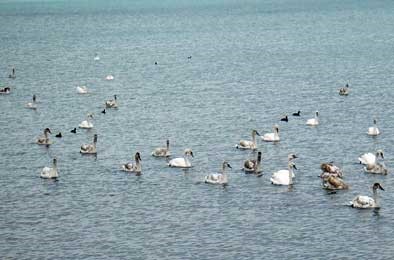Tue, 14/03/2023 - 13:09
Ornithologists made a record of waterfowl along the Turkmen coast of the Caspian Sea
Turkmen ornithologists have completed winter registration of waterfowl and wetland birds. Traditionally, the completion of winter birds' registration is timed to coincide with the World Wetlands Day which is marked on February 2, 2022. The scientists of the Khazar State Nature Reserve, one of the most bird-rich protected natural areas, also participated in the implementation of research programs. This reserve keeps records of the entire Turkmen sector of the Caspian Sea from Kazakhstan to Iran.

Ornithologist Alexander Shcherbina shared the details of the winter accounting of waterfowl. For the first time, a group of "accountants", including in addition to Alexander also his supervisor S. Mammadov and driver K. Chapyev, was able to cover the coast from the city of Esenguly to Cape Heles of the Cheleken Peninsula. The reserve staff surveyed the Southern and Northern Cheleken Bays, the same-name spits, the eastern shore of the Mikhailovsky Bay and the Darja Peninsula, the northeastern coast of the Balkhan Bay near the Dagada Peninsula and through the village of Garatengir went to the highway.
The weather conditions in January 2022 in Turkmenistan favored the implementation of accounting. The weather generally corresponded to the average norms of meteorological observations. The scientists noted the fact that the coastline and the water surface of the bays have undergone a strong transformation due to a decrease in sea level caused by a number of factors. This phenomenon has also been affected by the negative effects of global warming. On the northern shores, where rocky hills predominate, the drying of most of the lagoons, bays and creeks, that were previously favored by birds, has been recorded. The bio-intensity of the studied natural locations has significantly decreased, which eventually led to a reduction in the number of birds that arrived in Turkmenistan for the winter. On the lower central and southern coasts, the coastline shifted by kilometers, which negatively affected the possibilities of observation. A number of bird clusters could be estimated only in quantitative terms. Birds mainly spend the winter in the protected water areas of the Turkmenbashi, Balkhan, Northern Chelekensky and Mikhailovsky gulfs, the shallow waters of the Esengulysky branch of the reserve in the area from the village of Ekerem to the Iranian border.
The reserve staff members have recorded about 40 species of birds, including 3 species listed in the Red Book. The total number of recorded birds is 257 385. Among them are 5 curly pelicans, 2093 white-headed ducks and 12 895 flamingos. There are 3 species of swans wintering on the Caspian Sea. During the 2022 observations 4,267 mute swans and 549 tundra swans (which are quite rare for local latitudes) were recorded. About a hundred white swans were not classified by subspecies. Not a single whooper swan has been noticed. Seven hundred ducks have also not been identified. In the northern and central part of the Turkmen Caspian Sea the main species are the red-crested pochard, tufted duck, greater scoup, common goldeneye and common and red-breasted merganser. In the southern part of the Turkmen Caspian Sea the main species are mallard, northern pintail, common teal, wigeon and shoveler. The largest number of recorded birds are common coots (111 593), tufted ducks (56 808) and red-crested pochard (23 645).
More information can be found on Arzuw.news.
